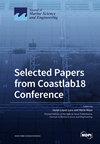浮力调节系统中平衡阀沉积物侵蚀的数值分析
IF 2.7
3区 地球科学
Q1 ENGINEERING, MARINE
引用次数: 0
摘要
对浮力调节系统中平衡阀的沉积物侵蚀进行了数值分析。在离散相模型的基础上,构建了平衡阀内部两相流的数值模型。讨论了沉积物对平衡阀的侵蚀速率,并考虑了五个参数的影响。结果发现,沉积物浓度和阀门开度的影响显著,而压差、沉积物密度和大小的影响适中。根据数值结果,侵蚀率与沉积物浓度呈线性增长,因此应避免在高浓度区域长期运行浮力调节系统。当阀门开度为 46.3% 时,冲蚀率最高,因此不建议在半开状态下运行。侵蚀率与压差的平方根成正比。不过,调节压差可能不是调节总冲蚀量的有效方法。次级流和主流的叠加导致颗粒与流体一起旋转,从而造成工作边缘的非对称侵蚀。工作边缘的侵蚀率随着沉积物粒径的增大而降低。相反,阀球表面的侵蚀率随着沉积物尺寸的六次方增加而增加。考虑到大颗粒更容易造成堵塞,建议在入口处安装海水预处理装置,以防止大颗粒沉积物进入阀门,提高浮力调节系统的工作寿命。本文章由计算机程序翻译,如有差异,请以英文原文为准。
Numerical Analysis of the Sediment Erosion of the Balance Valve in a Buoyancy Regulation System
Numerical analysis of the sediment erosion of the balance valve in a buoyancy regulation system was performed. A numerical model for the two-phase flow inside the balance valve was constructed based on the discrete phase model. The sediment erosion rate on the balance valve was discussed, and the effects of five parameters were considered. The effects of the sediment concentration and valve opening were found to be significant, while the effects of the pressure difference, sediment density, and size were found to be moderate. The erosion rate, according to the numerical results, increased linearly with the sediment concentration, so long-term operation of a buoyancy regulation system in high-concentration areas should be avoided. The erosion rate was the highest when the valve opening was 46.3%, so half-open operating conditions are not recommended. The erosion rate was proportional to the square root of the pressure difference. However, adjusting the pressure difference may not be an effective method for regulating the total erosion. The superposition of the secondary flow and the main stream caused particles to spiral along with the fluid, resulting in asymmetric erosion at the working edge. The erosion rate on the working edge decreased with the increase in the sediment size. Conversely, the erosion rate on the valve ball surface increased with the sixth power of the sediment size. Considering that large particles are more likely to cause a blockage, it is recommended to install a seawater pretreatment device at the inlet to prevent large sediments from entering the valve and to improve the working life of the buoyancy regulation system.
求助全文
通过发布文献求助,成功后即可免费获取论文全文。
去求助
来源期刊

Journal of Marine Science and Engineering
Engineering-Ocean Engineering
CiteScore
4.40
自引率
20.70%
发文量
1640
审稿时长
18.09 days
期刊介绍:
Journal of Marine Science and Engineering (JMSE; ISSN 2077-1312) is an international, peer-reviewed open access journal which provides an advanced forum for studies related to marine science and engineering. It publishes reviews, research papers and communications. Our aim is to encourage scientists to publish their experimental and theoretical results in as much detail as possible. There is no restriction on the length of the papers. The full experimental details must be provided so that the results can be reproduced. Electronic files and software regarding the full details of the calculation or experimental procedure, if unable to be published in a normal way, can be deposited as supplementary electronic material.
 求助内容:
求助内容: 应助结果提醒方式:
应助结果提醒方式:


